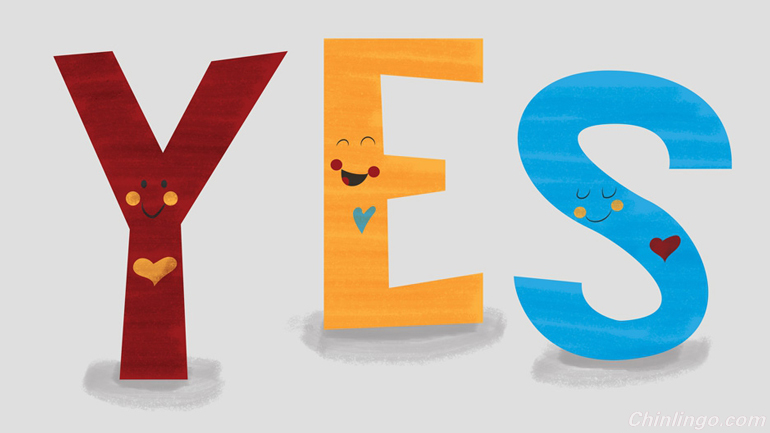
When to Use 是 (shì)?
什么情况下使用“是”?
1. Use 是 (shì) to connect two nouns
使用“是”连接两个名词
是 (shì) is used like the English verb “to be” when you want to connect two nouns together in a sentence to explain what something, or someone, is:
当你想要在句子里连接两个名词以解释某事或某物的时候,“是”的用法就跟英文里的动词“to be”类似。
我是美国人。(wǒ shì měi guó rén – I am an American.)
2. Use 是 (shì) in the phrase 是不是 (shì bú shì) to ask a question or confirm information
短语“是不是”里使用“是”,用以提出问题或者确认信息
The phrase 是不是 (shì bú shì) is one way of asking a question in Chinese. If you want to make a question out of a sentence that has 是 (shì) as its verb, you can do it by substituting 是 (shì) with 是不是 (shì bú shì) .
短语“是不是”是中文里的一种提问方式。当碰到带“是”这个动词的句子时以“是”作为动词的问句时,提问题的话可以将“是”换成“是不是”。
这是不是手机?(zhè shì bú shì shǒu jī. – Is this a cell phone?)
那是不是沙发?(nà shì bú shì shā fā. – Is that a sofa?)
苹果是不是一种水果?(píng guǒ shì bú shì yī zhǒng shuǐ guǒ? – Are apples a kind of fruit.)
However, 是不是 (shì bú shì) can also be added on to the end of a sentence to confirm something you think is true. For example, if you’re pretty sure someone is from China, you can confirm by asking:
还有,“是不是”也可以用在句子末尾,用来确认自己认为真实的事情。例如,要是你确定某人来自中国,那么你可以这样询问以确认:
你是中国人,是不是?(nǐ shì zhōngguó rén, shì bú shì. – You’re Chinese, aren’t you?)
You can confirm any type of information this way; it isn’t limited to sentences that already contain 是 (shì) as their verb. So if you call someone up at dinnertime, you could ask her:
你可以用这种方式去确认任何类型的信息,并且不局限于以“是”为动词的句子。因此要是你打电话给某人而她正在吃饭,你可以这样问她:
你在吃饭,是不是?(Nǐ zài chī fàn, shì bú shì. – You’re eating, aren’t you?)
The correct way to answer any of these questions is either 是 (shì), or 不是 (bú shì).
回答这种任何的问题的正确方式是,要么用“是”要么用“不是”。
3. Use 是 (shì) to keep a conversation going with the phrase “是吗? “(shì ma)
使用带“是”的短语“是吗”来持续会话
If you’re tired of trying to string together Chinese sentences and want to keep the other person talking, throwing in a 是吗? (shì ma). It’s the Chinese equivalent of something like “Oh, really?” or “Yeah?”
要是你厌倦了尝试连接起两个中文句子但又想继续和另一个人的对话,那么可以说“是吗”。这相当于是“OnOh, really?”或者“Yeah?”的中文对应词。
As long as you don’t make yourself sound exceedingly skeptical, the other person will take it as a sign that you're interested in what they’re saying and keep on going.
一旦你让只要你不让自己表现出非常怀疑的态度时,另一个人就会觉得你对他们所说的感兴趣,然后就会继续说下去。
4. Use 是 (shì) to agree in conversation
用“是”表达谈话过程中的同意态度
Another good way to show you’re following a conversation is to occasionally agree with the person you’re listening to. To do that, try using these 是 (shì) phrases:
另一个表示你在参与谈话的好方法是时不时表达你对倾听的那个人的同意态度。这种情况可以使用下面的带“是”短语“
是的 (shì de) is for mild agreement. It’s the equivalent of “uh-huh” or “yeah.” This mostly serves to show the speaker that you’re listening or you want to hear more.
“是的”表示温和的赞同,相当于“uh-huh”或者“yeah”。这个方式大部分用来向说话者表示自己正在听或者想听更多的内容信息。
是啊 (shì a) is a bit stronger. Now you’re not just being polite—you agree with what you’re hearing and you feel a bit excited about it.
“是啊”意味较重。你已经不止是表示礼貌,现在你是在同意听到的内容并且还感到有点兴奋。
就是 (jiù shì) is the most emphatic of the three. There’s no doubt in your mind that the speaker is correct and you want to express your agreement.
“就是”是三者中最具强调性的短语。对于说话者所说的内容你毫不怀疑,并且你想表达自己的同意态度。
When to not Use 是 (shì)?
什么情况下不使用“是”?
1. Do not use 是 (shì) to connect a noun and an adjective
不要用“是”去连接名词和形容词
In English, we say “The child is tall” or “The toy is soft.” Chinese people do not say “孩子是高” (hái zi shì gāo) or “玩具是软” (wán jù shì ruǎn) to communicate these ideas.
在英文里,我们可以说“The child is tall”或者“The toy is soft”。但中文里,同样的意思不能说“孩子是高”(hái zi shì gāo) 或者“玩具是软”(wán jù shì ruǎn)
Instead, use 很 (hěn)
这时候可以用“很”代替
Chinese sentences of this sort don’t require a verb. They typically include an intensifying adverb such as很 (hěn) between the subject and the adjective.
这类的中文句子不需要动词。它们用一些如“很”这样的代表词副词连接主语和形容词。
孩子很高 (hái zi hěn gāo. – The child is tall.)
玩具很软 (wán jù hěn ruǎn. – The toy is soft.)
2. Do not use 是 (shì) to connect a noun and a prepositional phrase
不要用“是”连接名词和介词短语
In English we say “My friend is in the library” or “The cat is on the table.” Not so in Chinese.
在英文里,我们可以说“My friend is in the library”或者“The cat is on the table”,但中文不这样。
Instead, use 在 (zài).
这种情况下,我们用“在”
在 (zài) is a preposition meaning “at”. If “at” doesn’t describe your location well enough, you can end your location phrase with a second preposition.
介词“在”的意思是“at”。要是“at”不够描述你的地点的话,那么你可以用第二个介词来结束地点短语。
It’s Subject + 在 (zài) + Location (+ Preposition)
结构是“主语+在+地点(+介词)”
我的朋友在图书馆 (wǒ de péng yǒu zài tú shū guǎn. – My friend is at the library.)
我的朋友在图书馆里 (wǒ de péng yǒu zài tú shū guǎn lǐ. – My friend is in the library.)
猫在桌子上 (māo zài zhuō zi shàng. – The cat is on the table.)
3. Do not use 是 (shì) to say “there is/there are”
不要用“是”表达“there is/there are”
In English, we use “to be” when talking about the existence of an object: “There’s a cat on the table,” “there are ants in the kitchen.” In Chinese? Not so much.
英文里, 我们用“to be”来谈论某物的存在,如“There’s a cat on the table”、“there are ants in the kitchen”。中文呢?我们不这样说。
Instead, use 有 (yǒu).
这时用“有”代替。
It uses the verb 有 (yǒu), meaning “to have.” 有 (yǒu) goes at the beginning of the sentence. No subject is necessary.
这里“有”的意思是“to have”。“有”可以用在句子的开头,这时无需主语。
有猫在桌子上 (yǒu māo zài zhuō zi shàng. – There’s a cat on the table.)
有蚂蚁在厨房里 (yǒu mǎyǐ zài chú fáng lǐ. – There are ants in the kitchen.)
The 是 – 的 (shì-de) construction
“是…的”结构
This is used to put emphasis on whatever words show up between the 是 (shì) and the 的 (de). You might hear it in a sentence like the following:
这种用法用于对“是”和“的”中间的词的强调。或许你听到过以下的句子:
树叶是绿色的。(shū yè shì lǜsè de. – The leaves are green.)



 闽公网安备 35020302035673号
闽公网安备 35020302035673号
0 responses on "You really know how to use "是" in Chinese"